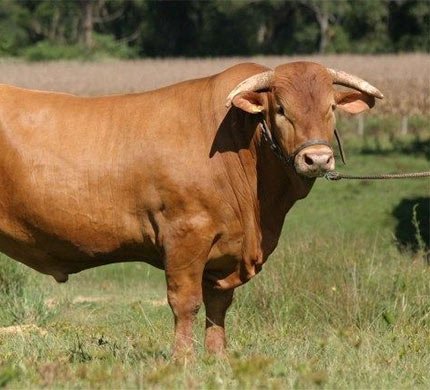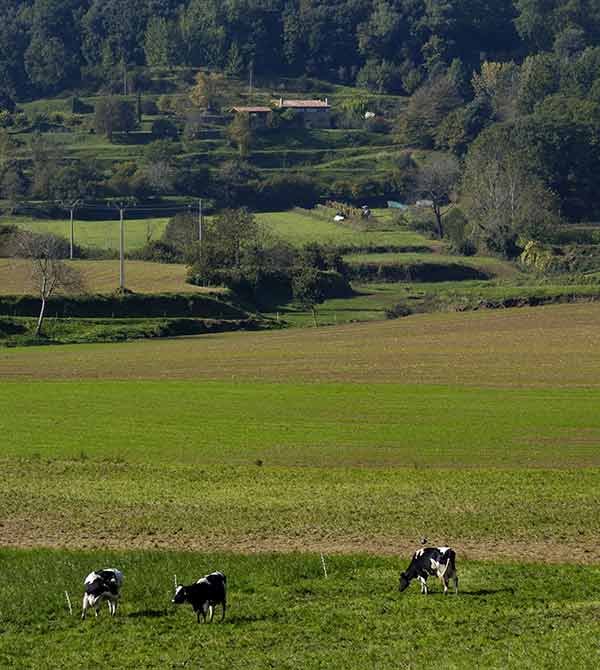Caracu Cattle
- Temperature:Between 40-80°F
- Milk:2-4 liters per day
- Food:Forage, Protein
- Pregnancy:Approximately 9 months
- Nationality:Brazil

General Information
Caracu cattle are medium to large-sized animals, with a distinctive hump on their shoulders and long, curved horns. They are typically a reddish-brown color, although some may be lighter or darker in color.
Caracu cattle are well adapted to the hot and humid climate of Brazil, as well as to poor-quality grazing areas. They are resistant to diseases and parasites and have a high tolerance for heat and drought.
While primarily a beef cattle breed, Caracu cattle are also sometimes used for milk production and draft work in some regions of Brazil. The breed is known for producing high-quality beef that is tender, juicy, and flavorful.
Where we find this cow to buy?
Caracu cattle are primarily found in Brazil, where they are considered a national breed. If you are located in Brazil, you may be able to find Caracu cattle for sale at local livestock auctions or from private breeders.
If you are located outside of Brazil, it may be more difficult to find Caracu cattle for sale, as they are not as well-known outside of their native country.
However, there are some international livestock import/export companies that specialize in the transportation of livestock, and they may be able to help you source Caracu cattle from Brazil or other countries where the breed is found.
It’s important to note that there may be restrictions on the import/export of livestock between countries, so you will need to research and comply with any applicable regulations before attempting to purchase Caracu cattle from outside of your country.
Additionally, you should only purchase livestock from reputable sources and ensure that the animals meet any applicable health and welfare standards.

How to increase milk production in Caracu Cattle
There are several strategies that can be used to increase milk production in Caracu cattle. Here are some possible approaches:
01
Providing Caracu cattle with a balanced and high-quality diet is essential for optimizing milk production. Cows should have access to plenty of fresh, clean water, as well as high-quality forage and concentrates that are rich in energy, protein, vitamins, and minerals.
02
Milking Caracu cows at the proper intervals and using proper milking techniques can help maximize milk production. Cows should be milked at regular intervals, typically twice per day, and should be milked using clean, well-maintained equipment.
03
Breeding Caracu cattle selectively for high milk production can help increase the milk yield of the herd over time. By selecting bulls and cows with higher milk production genetics, you can gradually improve the milk production potential of your herd.
04
Proper management practices, such as regular health checks, disease prevention, and good hygiene, can help maintain the health and productivity of your Caracu cows. By keeping your cows healthy and comfortable, you can help optimize their milk production potential.
Medicine
The medicines that are used for Caracu cattle are similar to those used for other breeds of cattle. Some common medications used for cattle include:
01
AntibioticsAntibiotics are used to treat bacterial infections in cattle, such as respiratory infections, mastitis, and metritis. They are administered by injection or in feed or water.
02
AnthelminticsAnthelmintics are medications used to treat internal parasites in cattle, administered orally or by injection. They are given on a regular schedule to prevent parasite infestations.
03
VaccinesVaccines are used to prevent a variety of infectious diseases in cattle, such as bovine respiratory disease, infectious bovine rhinotracheitis, and clostridial diseases.
04
Anti-inflammatory drugsAnti-inflammatory drugs, such as nonsteroidal anti-inflammatory drugs (NSAIDs), are used to treat pain and inflammation in cattle.
Pregnancy
Regular monitoring of pregnant cows can help identify any potential health issues or complications, such as dystocia. Close monitoring can also help ensure that the cow is gaining weight appropriately and that the developing calf is healthy.
It’s important to prepare for calving well in advance, by ensuring that appropriate facilities and equipment are in place and that a veterinarian or experienced breeder is available in case of any complications during the calving process.
Pregnant cows need a balanced and nutrient-dense diet to support their growth and development.
Pregnant cows should be up-to-date on vaccinations to prevent disease transmission.
Important!
By providing appropriate care and monitoring during pregnancy, Caracu cows can have a successful pregnancy and deliver a healthy calf.
Food
Caracu cattle, like all cattle, require a balanced and nutritious diet to maintain good health and productivity. A healthy diet for Caracu cattle typically consists of:
Caracu cattle are grazers and require access to high-quality forage, such as pasture grasses, hay, or silage.
Cattle require adequate protein in their diet to support muscle growth and other bodily functions.
Caracu cattle require a balanced intake of minerals and vitamins to maintain good health and productivity.
Access to clean and fresh water is essential for cattle, especially during hot weather and lactating.
Facts
Here is some facts about Caracu cattle:
Caracu cattle are a breed of cattle that originated in Brazil, specifically in the Caracu region of Minas Gerais.
Caracu cattle are considered a national breed of Brazil and are relatively common in the country.
Caracu cattle are primarily raised for beef production, but also used for milk production and draft work.
Caracu cattle are well adapted to the hot and humid climate of Brazil, as well as to poor-quality grazing areas.
Caracu cattle are typically bred through natural mating, although artificial insemination is also used in some cases.
Caracu cattle are medium to large-sized animals with a distinctive hump on their shoulders and long, curved horns.